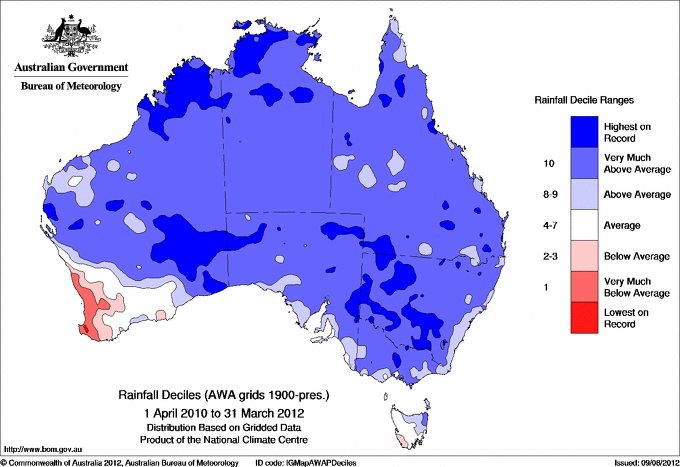La Nina declared by America and Japan, not yet by Australia
The U.S. Climate Prediction Centre (CPC) and the Japan Meteorological Agency (JMA) both declared on Thursday that La Niña conditions are present in the Pacific Ocean.

La Niña is one of three phases in the Pacific Ocean's El-Nino Southern Oscillation (ENSO) and it has a strong influence on weather patterns around the world. La Niña events can cause above-average rain over large parts of Australia, a more active Atlantic hurricane season and abnormally cool and dry weather in western parts of tropical South America, just to name a few.
In Australia, the last significant La Niña events occurred back-to-back between 2010 and 2012, resulting in Australia's wettest two-year period on record and widespread flooding.

Image: Rainfall deciles between April 2010 and March 2012, which was Australia's wettest 24-month period on record.
But while Australia can be significantly affected by La Niña, the Bureau of Meteorology is yet to join ranks with the CPC and JMA in declaring that La Niña is underway.
The Bureau currently has a La Niña Alert in place, rating the likelihood of La Niña developing in the coming months at 70 percent. While this appears to disagree with the American and Japanese climate monitoring agencies, the discrepancy simply comes down to a difference in criteria for declaring La Niña.
Put simply, both the CPC and JMA have slightly lower thresholds for declaring La Niña than Australia's Bureau of Meteorology does. The Australian rating system requires some key indicators to be a little bit stronger and be observed for a little bit longer before declaring a fully-fledged La Niña event.
Despite the contrasting information, it's clear that a La Niña-like pattern is clearly established in the Pacific Ocean and is expected to persist in the months ahead. This is likely to have an impact on the weather in Australia during the remainder of 2020.
Some of the main impacts of La Niña in Australia are above average rainfall, below-average maximum temperatures, and early monsoon onset and a more active tropical cyclone season.